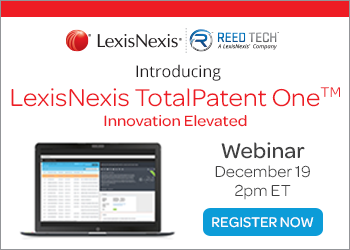TotalPatent One™ gives you comprehensive, on-point results with a fast and easy-to-use modern interface.
 LexisNexis TotalPatent One™ is a patent research solution designed to deliver on-point results derived from the most comprehensive and in-depth content collection of patent and non-patent literature available. The platform, which launched in September 2016, incorporates state-of-the-art search technology and user interface design, maximizes efficiency and delivers easy access to the answers users require.
LexisNexis TotalPatent One™ is a patent research solution designed to deliver on-point results derived from the most comprehensive and in-depth content collection of patent and non-patent literature available. The platform, which launched in September 2016, incorporates state-of-the-art search technology and user interface design, maximizes efficiency and delivers easy access to the answers users require.
LexisNexis TotalPatent One™ was crafted so patent professionals can confidently find the results they seek. Users can review their entire set of results on one easy-to-scroll page with no limit to the number of returned results. The results are enhanced by visual analytics that display metadata in charts and graphs so users can instantly analyze information on the authorities, assignees and class codes.
“Patents can be among a company’s most significant assets. In order to protect, develop and maintain these valuable assets, IP professionals need a patent research tool that yields both complete and relevant content from authorities across the globe. TotalPatent One™ was specifically created to deliver against these important requirements. Our customers need comprehensive results delivered with ease, speed, and efficiency; TotalPatent One™ successfully meets these critical needs head on,” said Ethan Eisner, Vice President and Managing Director of Global Commercial Markets.
 “TotalPatent One returns the most pertinent results quickly with a combination of comprehensive content, fast and innovative technology, and an intuitive user interface,” said Mike Hudelson, IP Product Planning Director.
“TotalPatent One returns the most pertinent results quickly with a combination of comprehensive content, fast and innovative technology, and an intuitive user interface,” said Mike Hudelson, IP Product Planning Director.
LexisNexis TotalPatent One™ makes researching patent documents easier and faster with state-of-the-art search technology and new user interface design that enables you to uncover reliable results in the most efficient manner. LexisNexis TotalPatent One™ is a part of a full suite of LexisNexis IP solutions, built by and for patent professionals, which span the patent workflow. With unparalleled breadth and depth of content and capabilities, these products have been developed to provide a comprehensive approach across the patent workflow with solutions that are uniquely designed to meet your needs as you prepare, draft, prosecute, defend, monitor and manage patents.
For more information you can request demo of LexisNexis TotalPatent One™ or register for a free webinar on December 19, 2016 at 2pm ET.
https://www.youtube.com/watch?v=T0f-dC-cA7Q&feature=youtu.be
Reed Technology and Information Services Inc., a LexisNexis company, is a sponsor of IPWatchdog.com.

![[IPWatchdog Logo]](https://ipwatchdog.com/wp-content/themes/IPWatchdog%20-%202023/assets/images/temp/logo-small@2x.png)

![[Advertisement]](https://ipwatchdog.com/wp-content/uploads/2024/04/Patent-Litigation-Masters-2024-sidebar-early-bird-ends-Apr-21-last-chance-700x500-1.jpg)

![[Advertisement]](https://ipwatchdog.com/wp-content/uploads/2021/12/WEBINAR-336-x-280-px.png)
![[Advertisement]](https://ipwatchdog.com/wp-content/uploads/2021/12/2021-Patent-Practice-on-Demand-recorded-Feb-2021-336-x-280.jpg)
![[Advertisement]](https://ipwatchdog.com/wp-content/uploads/2021/12/Ad-4-The-Invent-Patent-System™.png)







Join the Discussion
5 comments so far.
Joachim CS Martillo
December 19, 2016 03:08 pmBTW, I took a look at the Lexis/Nexis seminar. Because I listened while studying for the patent bar, I may not have fully absorbed everything, but it appears the search engine has been replaced with ElasticSearch, and the developers built a better more intuitive UI/UX by means of one of the front end JavaScript frameworks. It is a keyword search with no semantic analysis.
PatentOptimizer analyzes pantent/patent application structure. It sounds good, but I think I can identify some major missing pieces. To tell the truth, it should be integrated with a semantic analyzer, and some sort of search capability. The subject came up during the discussion, and the presenter asserted that the development team is looking at integration with a coming version of TotalPatentOne.
TotalPatentOne is a SaaS product and is on a one month release cycle.
Joachim CS Martillo
December 19, 2016 02:44 pmPatent optimizer looks useful.
I wonder what sort of experience patent prosecutors have had with it.
http://www.lexisnexis.com/patentoptimizerpromotional/
Joachim CS Martillo
December 19, 2016 01:52 pmThe URL for Klangoo is the following.
http://www.klangoo.com
Joachim CS Martillo
December 19, 2016 01:51 pmHere is an article describing early stage funding for a startup intending to automate patent prosecution and litigation processes.
https://artificiallawyer.com/2016/11/25/ai-start-up-legit-to-disrupt-patent-world-secures-seedcamp-funding/
Joachim CS Martillo
December 19, 2016 01:48 pmPatent practitioners need more than mere search. They need text analysis to determine key topics and key words in the patent specification and whether those key words are defined in the specification, in the art (synchronically with priority data), or in common usage (synchronically with the priority date).
Practitioners also need claim writing assistance, claim parsing, and automatic claim chart generation to identify support within the specification.
A rule based expert system to help with generating proper responses on time to the patent office with the correct fees would probably be helpful.
I know that funding is out there for developing this sort of software.
[See next posting for an article URL.]
The software should be developed in the context of litigating or prosecuting patents. Otherwise, it would be hard to trust the software offered to patent professionals.
I have been experimenting with Magnet from Klangoo. It is a semantic analysis tool which targets increasing eyes on a website. The demo can be found at the following URL.
http://demo.klangoo.com
The back end database of the demo is not really helpful for prior art searches, but the text analysis functionality does not seem to do a bad job in identifying key terms in claims or in the text of the patent specification.
I wonder whether such a semantic analysis tool could be customized to help make sure that the claims are fully enabled and supported in the specification and whether (with a more appropriate back end database) it could help with claim charting and with creating a patent application lexicon based in the patent specification, in the terminology of art, and in ordinary linguistic usage.